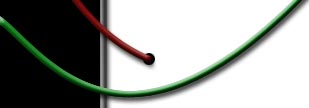| |
What is
Antimatter? - Page 4
Maria Spiropulu, a physics
doctoral candidate at Harvard, responds:
Let's start by defining matter. People have asked
"what is matter?" for quite a long time. Democritus,
the ancient Greek philosopher and mathematician, envisioned
structure in the building blocks of everything and he called
the basis for this structure an atom; he wrote, "nothing
exists except atoms and empty space: everything else is opinion."
At the atomic level, the world can be described in terms of
the elements, including
hydrogen, oxygen, carbon and the like.
As it turns out, though, atoms are not the fundamental
constituents of matter. When we zoom closer into matter, by
probing at smaller distances, the subatomic world unfolds.
The closer we look, the stranger this world, the quantum world,
actually behaves. We can not make a direct connection with
it: at a small scale, objects do not behave like rods or balls
or waves or clouds or anything we have ever directly experienced.
But the quantum mechanics of this world does let us describe
how atoms form molecules.
It also enables us to depict the "motion"
of certain particles inside atoms. Indeed, atoms are made
of electrons that whiz around the fixed protons and neutrons
in their nuclei, which are made of quarks. These particles
all interact with each other by means of "force messenger"
particles, such as photons, gluons, W's and Z's. Based on
the attributes of these particles, we assign them identification
numbers, or quantum numbers. And by means of symmetries and
conservation laws involving the quantum numbers of the particles,
we can describe their interactions. Examples of such numbers
are charge and intrinsic angular momentum, or spin.
If a is any particle and this particle has no
attributes other than linear and angular momentum (which include
energy and spin), then a is its own anti-particle--one of
the constituents of antimatter. For example, the photon is
its own anti-particle. If a particle has other attributes
(such as an electric charge Q), then the anti-particle has
the opposite attributes (or a charge of -Q). The proton and
neutron have such attributes. In the case of the proton, its
positive charge distinguishes it from the negatively charged
anti-proton. The neutron--although electrically neutral--has
a magnetic moment opposite that of the anti-neutron. Protons
and neutrons have another quantum number called the baryon
number, which also has the opposite sign in the corresponding
anti-particles.
<-
Previous | Next
->
|
|










